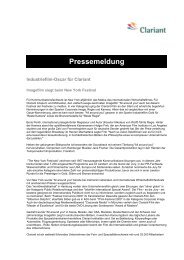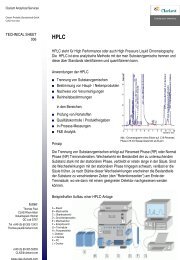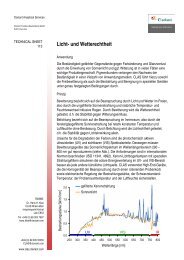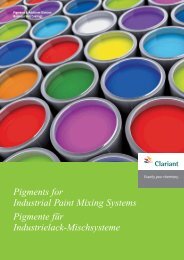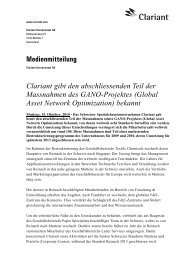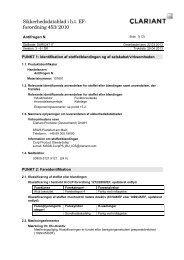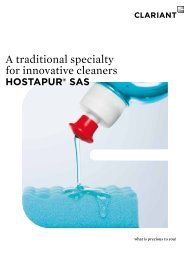CESA® Additive Masterbatches - Clariant
CESA® Additive Masterbatches - Clariant
CESA® Additive Masterbatches - Clariant
Create successful ePaper yourself
Turn your PDF publications into a flip-book with our unique Google optimized e-Paper software.
A Global Portfolio of<br />
Performance Enhancements<br />
UV Stabilizers<br />
Light radiation and oxygen in the air trigger<br />
decomposition processes in plastics that<br />
not only change their appearance, but<br />
also adversely affect their mechanical<br />
and physical properties. Light stabilizers<br />
are used to protect plastics from discoloration,<br />
embrittlement and eventual<br />
degradation caused by exposure to<br />
ultraviolet light. Applications include<br />
agricultural films, construction materials,<br />
lawn and garden equipment, signage<br />
and many other products used outdoors,<br />
as well as products exposed to fluorescent<br />
light and filtered daylight indoors.<br />
Flame Retardants<br />
Flame retardant additives make plastics<br />
safer by making them more difficult to<br />
ignite and by controlling their burning<br />
behavior. Widely used in transportation,<br />
construction, appliance and electronic<br />
applications, flame retardants help<br />
manufacturers meet UL and other regulatory<br />
requirements by minimizing flame<br />
propagation, smoke and heat generation.<br />
Antistats<br />
Antistatic agents prevent a buildup of<br />
static electricity on polymer surfaces.<br />
Static charges not only attract dust and<br />
dirt, but can also cause sheet or film<br />
to cling, stacked polystyrene cups to<br />
stick and powder to bridge. A sudden<br />
discharge can create sparks that may<br />
damage products such as computer<br />
chips and also invite risk of explosion in<br />
hazardous areas. Antistats help avoid<br />
such problems, while also improving<br />
processability and mold release.<br />
Antiblocking/Slip Agents<br />
Antiblocking and slip agents modify the<br />
surface of polymeric sheet or film, making<br />
it rougher or more slippery. They are<br />
used to prevent thin films,<br />
sheets and thermoformed<br />
articles from adhering to<br />
each other and to the<br />
metal surfaces of thermoforming<br />
equipment during<br />
processing.<br />
Antislip Agents<br />
Filled polyethylene<br />
heavy-duty bags have a<br />
tendency to slip and slide<br />
when stacked in layers,<br />
such as on pallets. The<br />
addition of antislip agents<br />
improves stackability by<br />
roughening the surface<br />
of the film, reducing its<br />
slip properties.<br />
Corrosion Inhibitors<br />
Typically added to packaging films,<br />
corrosion inhibitors protect the<br />
appearance and extend the service<br />
life of metal parts and components.<br />
Antimicrobials<br />
Without antimicrobials, bacteria and<br />
spores can grow on the surface of<br />
plastics, resulting in staining, odor and<br />
other undesirable characteristics,<br />
including premature product failure.<br />
Antimicrobials protect plastic film, fibers<br />
and molded products against bacterial<br />
growth, fungi, mold and mildew.<br />
Antioxidants<br />
Antioxidants, often called heat stabilizers,<br />
are organic substances that<br />
inhibit or retard polymer oxidation and<br />
its degrading effects. These include<br />
discoloration, change in viscosity, loss<br />
of physical properties, loss of clarity,<br />
and surface crazing or cracking.<br />
Processing Aids<br />
LLDPE, LLPDE-rich blends and metallocene<br />
resins are often extremely<br />
difficult to extrude due to severe<br />
problems with melt fracture during<br />
processing. Processing aids are<br />
designed to coat the inner surface of<br />
the extrusion die, reducing friction<br />
between the melt and the metal to<br />
facilitate processing.<br />
Laser Marking<br />
Although several laser sources<br />
are used to mark plastics, the most<br />
common is the Nd-YAG system.<br />
Extremely flexible, it works by<br />
scanning or tracing, resulting in an<br />
excellent fine and indelible print.<br />
1



